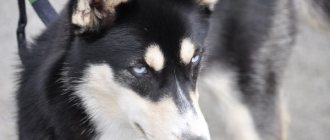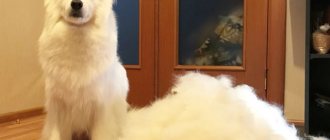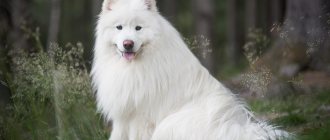American Hairless Terrier
A dog with an extraordinary appearance
In essence, AGT is a breeding marriage of rat terriers. In the 70s of the last century, a completely hairless puppy appeared in a litter of rat terriers. The owner of the bitch did not destroy the puppy, selling it to a friend. When Josephine, as the puppy was named, grew up, she became the ancestor of a new breed.
American Hairless Terriers are not as good rat catchers as their ancestors. However, representatives of the breed are quite capable of coping with small rodents. If an AGT is purchased as a family pet, the ideal option would be to avoid decorative rats, mice and hamsters in the same area as it.
Hairless Terriers are intelligent, very energetic, independent and curious. They are kept both in apartments - as companions, and in country houses.
Yorkie food
A balanced diet is important for both puppies and adult Yorkies. They eat little by little, but the food must contain enough nutrients.
What to feed your Yorkshire Terrier? Yorkies should eat special dry food designed for Yorkshire terriers or small decorative breed dogs, canned food, and natural products.
Products prohibited for Yorkshire Terrier consumption:
- bones;
- pork;
- sweets;
- potato;
- fresh bread;
- legumes;
- raw fish;
- juice;
- raw eggs.
It is important to follow the diet: puppies are fed 6 times a day at first, and the number of meals is gradually reduced. By 10 months, Yorkshire terriers are accustomed to feeding twice a day and this schedule continues throughout their lives.
English toy terrier
How much self-confidence there is in this look!
The breed appeared in the middle of the 19th century, was called the “black and tan terrier” and served as a rat catcher. At the beginning of the 20th century, black and tan terriers were divided into several classes (based on weight), the smallest dogs, whose weight was no more than 2.6 kg, were called Manchester terriers. Later they were renamed English Toy Terriers.
The breed in its pure form is rarely found outside of England.
English toy terriers continue to exterminate rats, in addition, they became the ancestors of other rat-catching breeds.
Homemade methods
It is not at all necessary to buy ready-made traps or adhesive mixtures; you can make devices for catching them yourself.
From a plastic bottle
Traps made from plastic bottles are inexpensive, but they almost always help catch unpleasant inhabitants.
Let's consider several device options:
- Device made from a plastic bottle with a volume of 20 liters. Pour 20-30 grams of refined oil into it and distribute evenly over the walls. Place a piece of lard or sausage in the container. A homemade trap is placed under the edge of the countertop. Take a piece of cardboard, from which a bridge is cut out to connect the neck of the bottle to the table. The trap is reinforced with books and can also be tied to a table. Once a rat gets into it, the slippery walls will not allow it to get out;
- Trap from a plastic bottle “sharp petals”. A small one and a half liter bottle is suitable for this; the upper part of the neck is cut off. Numerous cuts are made along the workpiece with a length of 5 to 8 cm. A piece of bait is placed at the bottom of the container. The resulting petals are bent inward. The rat gets inside the trap, and the sharp plastic parts that stick out inside the container will not allow it to escape.
Using a grid
To make a trap you will need the following materials:
- Mesh made of a metal base with small cells;
- Wire cutters;
- Wire;
- Small magnets - 2 pieces.
When making a rat trap from a mesh, you should follow the following steps:
- From a piece of metal mesh, cut 5 squares of the same size;
- Next, the squares need to be fastened together with wire so that it looks like a cage;
- A door is made from wire and mesh;
- Magnets are installed on the area of contact between the door and the cage;
- A small piece of wire is cut. One end of it is threaded into a metal box, and the other onto the door;
- The bait is attached to the wire.
After the rat enters and eats the bait, the door automatically lowers. The pest's exit from the trap is blocked.
Electrical device
To build an electrical device you need to have some knowledge in the field of electrical engineering.
During manufacturing, you should follow the following instructions:
- Two strips with a length of 50 cm and a width of 10 cm are cut out of tin;
- The ends of the workpieces are connected using electrolytic capacitors;
- It is worth attaching wires from the outlet to them;
- To reduce the power you need to connect a resistor;
- The remaining ends of the rectifier should be connected to a current source;
- Next, the resistor is soldered, its second terminal must be free.
It is recommended to install the finished device in places where rats are expected to live. As soon as the rodent comes close to him, he will be shocked.
From a metal pipe
To make a trap, first prepare the components from the list:
- A small piece of metal pipe with a length of 50 cm and a diameter of about 14 cm;
- Sheet aluminum;
- Ruler;
- Drill;
- Pliers;
- Wire.
When constructing the device, it is recommended to follow the following procedure:
- Two holes must be drilled at each edge of the pipe;
- In the same way, several ventilation holes are made along the entire length;
- Doors for the trap must be cut from a sheet of aluminum;
- Two holes are made in the doors;
- Wire loops are inserted;
- The doors are hung in prepared holes on the pipe;
- A large bait is placed inside the pipe, which can quickly attract a rodent.
From a flower pot or jar
You can make a good trap at home from a flower pot or jar.
Everything is done simply:
- A large jar or pot should be turned upside down;
- A small piece of plywood or plastic must be sharpened with a knife. A piece of bait should be placed on it;
- The resulting device with bait is installed on the rib area;
- The edge of a jar or pot is lowered onto it.
As soon as a hungry animal gets under a pot or jar, it will begin to actively eat the bait. The piece of plywood or plastic will lose its balance, and the rodent will be trapped.
West Highland White Terrier
One of the most adorable breeds...
“Vestiki” is 8 kilograms of mobility, an extraordinary mind and the habit of being in the center of attention. Modern representatives of the breed are more likely to be companions than hunters. But with the right approach to training, these kids are still capable of showing a master class in catching rats, otters and badgers.
In former times, the snow-white color of dogs was not valued. Such babies were rejected immediately after birth, considering them too painful. Everything changed at the end of the 19th and beginning of the 20th centuries, when white terriers began to be bred.
West Highland White Terriers are playful and active into old age.
As for training, the dogs are smart, but very stubborn. To achieve certain training goals, the owner will have to make every effort and it is not a fact that everything will work out.
History of the breed
One of the 14 most ancient dogs in the whole world, its history dates back to the deep past.
As often happens in such cases, the exact date of occurrence of the rarity is difficult to establish. Someone dates the found remains of similar animals to the second millennium BC. There are also supporters of earlier dates; they rely on images of similar animals dating back to the 6th-8th millennium BC. Be that as it may, already in the 6th century the Japanese state seriously began to strengthen and develop the best qualities of the dog.
It should be noted here that this is one of the rare breeds that developed for a long time without foreign impurities. Residents of the island state approached the issue responsibly. They created instructions on all issues related to breeding, maintenance and training.
And in the 15th century, stud books began to be kept, in which the names, pedigree, color and other characteristics of each specimen were meticulously recorded. Up until the mid-19th century, dogs were smaller. According to documents from 1603, in the Akita district, where their organized development began, similar specimens were used in dog fighting.
Akita Inu is a loyal dog with a balanced character
After the mid-19th century, they began to be crossed with Tosa Inu (Japanese Molosser) and mastiffs, which led to an increase in size and the appearance of the textbook appearance of Spitz dogs. At the beginning of the 20th century, fighting between dogs was banned, but the Akita Inu breed continued to develop. It strengthened its position by becoming one of the nine chosen ones, receiving the title “Nature Monument” in 1931.
But then World War II came, and all work on further development stopped abruptly. Many dogs were subjected to mass extermination, only German shepherds were left untouched. To protect and save their beloved Akitas, some breeders have gone to extreme measures.
They secretly bred them with German Shepherds and hid them in remote places. The rock gradually eroded and was in danger of destruction. Just before the war, the Japanese Akita Inu crossed the ocean and came to America. Presumably, this was facilitated by the famous deaf-blind American writer Helen Adams Keller.
Having visited Japan and learned the story of Hachiko, she became eager to have such a dog. She was given two Akita puppies one after another, because it is difficult to refuse such a courageous and talented woman. This is how the American variety appeared.
Jack Russell Terrier
Ready for a fight with rodents!
"Dzhekushki" were bred for hunting small game. Hence the love for digging up someone's holes, chasing neighbors' cats and spending many hours watching ornamental rodents.
Representatives of the breed living in the private sector do an excellent job of hunting rats and mice. Dogs strangle rodents and bring them to the doorstep of the house to show off the results of their work.
Urban “jacks” have an insane amount of energy. They are active, love to bark, are quite aggressive towards their own kind and wary of strangers. Those who are ready for many hours of walks in any weather can get such a dog.
How to raise a hunter
Purchasing a rat-catching dog is by no means a guarantee that it will perform its functions. It is very important to raise your pet correctly, to instill in him a love of stalking, tracking and catching. Therefore, a rat catcher should be raised from early childhood. The dog must know that it is a working dog and not a lap dog, so it is unacceptable to show excessive tenderness to the animal. Strictness, but the absence of shouting and especially physical violence - these are the main elements of the educational process and training.
Proper education is the key to ensuring that the natural potential of a rodent hunter will be fully revealed.
Ratcatchers are a special category of dogs that helped get rid of rodents and may have saved Europe from complete devastation by stopping the plague epidemic. Now they are actively used to protect suburban real estate, warehouses, and barns.
Yorkshire Terrier
This cute dog is a real rat catcher!
One of the most common small breeds. Charming “Yorikis” do not fit in with rat-catching dogs, but it’s a different matter with exhibitions. However, the ancestors of the breed were Scottish terriers - serious, active dogs and the main enemies of small rodents.
Among the current Yorkshire Terriers it is difficult to find a working puppy.
Most dogs purchased from elite kennels are show class.
Qualities of rat catcher dogs
It is interesting that initially small hunting dogs were chosen by their coat color. Preference was given to light-colored dogs: it was easier to see them in the darkness of holds, barns, and workshops.
To prevent the skin from looking too dirty, there had to be darker spots on it. But, as can be seen in the photo of rat catcher dogs, today this item is not a priority.
Over many years of selective breeding, gray, brown and even black breeds were introduced. In addition to the color of the dog, producers were selected based on size: hunters had to make their way through narrow passages and crawl into small crevices.
Cairn Terrier
How can you not be touched...?
People adored small, brave and active dogs. Pointy-eared Skye Terriers, being fearless, enthusiastically destroyed small rodents and predators, protected and entertained their owners, and fought against a passive lifestyle.
Nowadays, the pointed-eared Skye terriers are called Cairn terriers, but the renaming did not affect their habits and character. Dogs remain passionate, extremely active, courageous and restless.
Representatives of the breed will be happy to dig up a flower bed, chase a cat, or take a decorative rodent out of a cage.
And if the pet lives in a private house, rats and mice will quickly evacuate from there. Those who don't make it in time will become the prey of the Cairn Terrier.
Jagdterrier
This small dog (weight up to 11 kg) is a born hunter. Actively catches rodents and protects the territory from strangers.
The Jagdterrier has one significant drawback - it rushes and barks at all moving objects. Therefore, keeping representatives of this breed can present significant difficulties in areas where other animals (cats, rabbits) or birds (ducks, chickens) live.
If you need a responsible and skillful “specialist” to protect your home from rodents, but it is not possible or desirable to have a cat, then pay attention to one of the listed breeds. These dogs have very different characters and appearances, so choosing a pet to your liking will not be difficult.
German pinscher
No, this is not a Doberman.
An intermediate link between the Doberman and the Miniature Pinscher. German pinschers are tireless hunters, actively exterminating mice and rats. For its activity and fearlessness, the breed is loved in its homeland, where it is also kept as companions.
Small, nosy dogs are just that kind of thing. Not only is the breed not particularly popular in the world, but its representatives also have a tough character.
The German Pinscher is able to “build” the family in which he lives and constantly shows who is the true master of the house.
Pinschers are very energetic and active. When getting such a pet, you should say goodbye to spending time passively.
Industrial live traps
A typical industrial rat trap is a small cage with a spring-loaded door that opens upward. When opened, the door is secured with a guard, the lower part of which is located inside the cage and has a loop. The bait is hung on a loop.
When the rat gets into the cage and begins to pull the bait, the guard moves, releases the door, and it slams shut.
This principle of operation has proven to be the most effective for live traps, and therefore the vast majority of rat traps work this way.
A cage trap allows you to catch a rat very quickly: sometimes the pest is caught on the very first night after installing the rat trap in the house. To get this result, a rat trap is installed where the pest has previously been seen, or where the animals constantly leave traces of their activity - chewed food, wool, excrement.
It is advisable not to enter the room where the trap is installed, so that the animal gets out of the shelter as soon as possible and becomes interested in the bait.
https://youtube.com/watch?v=7cYCD6HvAlk
A standard live trap in the form of a cage costs about 400-500 rubles.
Norfolk Terrier
A walking rectangle with a fiery disposition
Another creature that can resist rats. Norfolk Terriers were used as badger hunters and destroyers of small rodents. To this day, hunting instincts take their toll, and finding a terrier next to ornamental rodents is a death sentence for the latter.
Charming babies are mainly kept as pets.
Behind the pleasant appearance lies a real “terrier” character: independence, curiosity, stubbornness and fearlessness.
If you start raising a pet from a young age, you will end up with an animal that actively controls the owner and his family members.
Norfolk Terriers, due to their mobility and activity, need long walks and all sorts of ways to release energy.
Training and education
Judging by the appearance of the animal, many believe that this is a killer with a merciless character. But in fact, an attack on a person, including the owner, can only occur in the event of cruelty to a dog.
If during the training process the owner uses physical force, beats the pet, and does not feed it for several days, the animal will turn into a cruel dog. It will also attack if there was a training on a person.
But this does not mean the dog is cruel. Even less formidable animals can show aggression with such training methods. The maximum that can be allowed during classes is to raise your voice. But if you want to get a loyal, good friend, show care, kindness and affection. And the dog will respond in kind.
Training must begin from puppyhood. Already at this age, you should show the dog who is in charge. Here it is worth showing firmness, otherwise the trait of dominance will take over as you grow older. The dog will try to dominate even over the owner and it will be difficult to get rid of this trait.
First, the puppy must clearly understand its name, and then you can begin to accustom it to the commands “Near” and “Sit”. It is better to conduct the first lessons while keeping the dog on a leash. The leather collar should be wide so as not to damage the animal's fur.
The pet is more willing to follow commands if in return it receives not only praise, but also a favorite treat.
Socialization of a puppy involves frequent exposure to people and other animals. To do this, you can take your pet on public transport, walk in a crowded park or along city streets, or go out of town for picnics. This will not only help the dog get used to society, but will also prevent aggression.
The Great Dane's sharp mind and quick wit make it possible to teach the puppy to follow commands quickly. It is enough to give a clear command to the dog once so that he understands what his owner wants from him. If the puppy follows a command several times in a row, do not force him to do it endlessly. The pet learned the exercise. It is better to repeat it in a day or two.
Training is carried out several times a day for 15 minutes. This way the pet learns the exercises better and does not become overtired. You should not use elements of protective guard training in the training process if the dog is not intended for these purposes. Otherwise she will become aggressive.
Prague rat
The ears are just adorable!
Lively, brave dogs gained popularity in the Middle Ages, when the activity of rats increased manifold. Unsanitary conditions contributed to this, and the cats at first could not cope with their duties, and then were practically destroyed.
Europe learned about rat-catching dogs only in the 7th century; before that, Prague rat-catching dogs served in their homeland. Perhaps, European fame contributed to the preservation of the breed, because in the 8th century, when the fight against rats was no longer so obvious, the dogs were forgotten.
The current Prague rats are tireless enemies of rats, glorious friends of man, unusually active and gambling animals. There is an opinion that pets are stubborn, but among them there are dogs that take part in various types of canine sports.
If you keep a dog in an apartment, it will not be good for the decorative rats and hamsters that live in the same area as him.
If the Prague rat lives in its own house, hunting instincts will take over, and local rodents will be destroyed.
Working qualities
The most suitable working qualities for rat catchers were considered to be:
- Good sense of smell and hearing, allowing you to smell a rat in a large room;
- Fearlessness and courage;
- A lively mind and the ability to instantly make decisions without the participation of the owners;
- Fast reaction;
- Strong teeth and claws;
- Excitement that allows you to forget about the sense of self-preservation.
The required external data were:
- Flexible and strong body;
- Strong paws and jaws;
- A long muzzle that helps you get into the narrowest holes.
Today, breeds of small long-haired rat-catching dogs perform more decorative functions and become excellent friends and companions of people, so they are required to: Kindness to all inhabitants of an apartment or house, loyalty and devotion.
Such animals coexist quietly with other dogs and cats. But they won’t be able to make friends with rats, hamsters and guinea pigs. Decorative rodents will invariably make you want to destroy them.
Ratonero
Now he will catch up with the rat, and that will be the end of it.
The second name of the breed is the Andalusian tavern rat catcher. The ancestors of the ratoneros are fox terriers and Andalusian terriers; the breed appeared in the middle of the 19th century. Its main task is to destroy the hordes of rats and mice that inhabited wine cellars at that time.
Nowadays the ratonero is still the same hunter, determined and uncompromising. Representatives of the breed continue to exterminate rats on farms, in private sectors and on the streets. Andalusian tavern ratcatchers are not the most suitable dog for passive people who do not want to spend time training and walking their pet.
A spoiled ratonero is a natural disaster.
Such a pet will destroy the apartment, will make trouble with the neighbors, bringing them to their white knees with a shrill bark, and will try to rush at passers-by. Yes, and the family will not have a good life from a restive dog that wants to prove its dominance.
Care
The breed is designed to live indoors. The rat needs a specially equipped place to rest. A bed or house is suitable for this purpose. The dog's sleeping area is placed in a warm corner where there are no drafts. Rat rats love to hide food, so they systematically clean the bed. The dog will also need a litter box to go to the toilet.
Owners gently wipe their pet's eyes with a soft cloth soaked in chamomile solution 1-2 times a week. The dog's ears are treated once every 2 weeks. Krysarik's teeth are subject to rapid plaque settling. They are cleaned at least 3-4 times a week
Due to their low weight, Ratman’s claws are difficult to grind down, so they are carefully trimmed monthly
Ratlik's coat is short and does not require much time for grooming. The dog is brushed with special brushes 2-3 times a week. The long-haired variety is combed with combs 3-4 times a week, and daily during the molting period (spring and autumn). There is a restriction on water treatments: no more than 5-6 times a year. The dog is washed in the evening using shampoo for short-haired breeds. Dry well with a towel and dry with a hairdryer if necessary.
For being outside during the cold season, Ratman is provided with overalls. Protect paws from freezing with rubber boots. At home, the pet is insulated with knitted sweaters.
Advice! Ratman is given 30-60 minutes to walk twice a day.
Russian toy terrier
It's hard to believe that this little guy is a rat catcher
Descendants of English toy terriers, famous as excellent rat catchers. Today's Russian Toys are parlor dogs, small companions, and there are many Russian celebrities among their owners.
However, pets living in their own homes sometimes demonstrate hunting qualities by bringing back strangled mice and rats. Apartment toys are not averse to hunting decorative rodents, so keeping them together is very problematic.
Useful tips
To effectively catch rats using baited traps, follow these tips:
- Not only meat, lard, seeds and vegetable oil are used as bait. An excellent substitute would be cottage cheese, boiled rice, and slices of bread. Only fresh and aromatic products are used, otherwise the rodent will not approach them.
- Traps are placed in areas where a large number of pests have been observed. Ideally, right in the hole. But first they find out whether she is residential or not. To do this in the evening, you need to place a crumpled sheet of paper at the entrance. If the leaf is torn or moved in the morning, it means the hole is inhabited.
- Traps are set against the movement of pasyuks. They usually move along walls, as well as in areas where the least amount of light penetrates.
- Rats care about their own cleanliness, so they will prefer to move along a clean path if possible.
- The trap is regularly washed with a solution of baking soda or ash lye, then ventilated and dried. If the mousetrap emits an unpleasant odor, this will only repel rodents.
Rats are cunning, cautious animals, so you have to work hard to catch them. They enter the home through thresholds, sewer pipes, and can climb vertical pipes and walls.
Neighborhood with rodents is unlikely to please anyone, so it is necessary to act immediately after discovering the animals. The listed control methods, traps and baits are sure to give a positive result if the presented recommendations are strictly followed.
Rat Terrier
True Terrier
Rat terriers were once excellent rat catchers, as the name suggests. American colonists valued these dogs very much, using them as a live bell and also for hunting small game and rodents.
Now the main purpose of rat terriers is almost forgotten; they have been turned into cute companions. But in American prisons, dogs still help in the fight against rats to this day. In addition to exterminating rodents, representatives of the breed are used to search for drugs and in various types of canistherapy.
Schipperke
An exceptionally dexterous rat catcher, a brave guard and a vigilant watchman. And although representatives of this breed are modest in size (weight does not exceed 9 kg), they trace their ancestry back to massive herding dogs.
Once upon a time, Schipperke traveled around the world on ships, exterminating rats living in the holds. Now these dogs are successfully using their skills to protect private households.
Dachshund
The creature is small but brave
“Tram”, “sausage on legs” - dachshunds earned these nicknames for their funny exterior. Small, long dogs are kept in apartments; they have long been made companions. And few people know: the Germans bred the breed for burrow hunting, and the dogs also helped in the fight against rats.
The dachshund is a walking curiosity. Anything that interests the dog is subject to immediate consideration. It doesn’t matter to the pet whether there are wires in front of him or the owner’s shoes, the dachshund will definitely try the objects to his teeth.
The breed is rarely used for its original purpose, so buying a working puppy is very problematic.
However, instincts appear when the pet sees a decorative rat or other rodent. Some dachshunds hunt cats, although the latter often fight back.
Miniature Schnauzer
The Miniature Schnauzer originates from Germany, where it was bred by farmers to be efficient rafters.
- This breed usually comes in black, black and silver, white, or a salt and pepper mix. The Miniature Schnauzer is also known for its coat, trimmed like a beard, mustache and eyebrows.
- Despite its size, this breed can be an excellent guardian dog, completely devoted to its owner and family.
- The Miniature Schnauzer is also a very smart, fun-loving dog that loves to be with children. If you live in an apartment, this dog will be the ideal companion for you. This breed is very calm indoors, given that it gets a daily dose of exercise and walks.
Features of mating, pregnancy, childbirth
Rats who have reached 18 months of age are considered sexually mature. Pairs are selected taking into account their pedigree.
The limited number of purebred Prague Ratfish makes it difficult to find a suitable mating partner. It is desirable that the dogs be of the same breed and have a similar coat color.
At the time of mating, the male and female must be completely healthy. Physiologically, the female Ratfish is ready for mating between the 10th and 14th day of estrus. Future partners are introduced in advance and given time to walk together. The owners are present during the mating of the dogs. A follow-up appointment is usually made every other day to ensure fertilization.
Signs of pregnancy appear in female Ratfish at the beginning of the second month. From the 5th week, the belly becomes rounded and grows, and the mammary glands swell. The bitch must be closely monitored and sudden movements and overloads avoided. The dog's diet includes increased amounts of protein-rich food (meat, fish).
At each stage of reproduction, a dog has a special feeding regime, characteristic only for this stage, keep this in mind!
The gestation period for female Ratfish lasts 6-7 weeks. After day 60, the dog's body temperature is measured daily. Elevated readings of 36–37 C signal the approach of contractions. Ratman's fragile physique makes the normal course of childbirth difficult. It is best to carry them out with the support of a veterinarian. There are from 2 to 4 puppies in the litter. The bitch independently feeds the offspring until 6 weeks of age. If, with numerous offspring, the mother does not have enough colostrum, it is recommended to supplement the mother with a bitch's milk replacer.
Labrador Retriever
Talented dogs from medium to large sizes. According to the standard, the ideal height at the withers is 54 – 57 cm.
Classic colors of Labradors are black, chocolate, fawn of all shades.
The coat of a purebred Labrador Retriever is short and smooth throughout the body. Repels water and dirt well. Dogs with combing, wavy or curly hair are rejected.
Labrador retrievers are famous for their intelligence and tact. They work as guides and water rescuers. They are popular all over the world. In the United States, every year they take 1st place in the ranking of the most common domestic dogs.
Medium-sized, smooth-haired dogs live happily in city apartments and rural houses. They do not require complex care and quickly adapt to the family’s lifestyle.
What is the difference between an Akita Inu and a Shiba Inu?
Some people's living conditions do not allow them to have a large dog. A small Akita Inu, a breed called a Shiba Inu, will suit them. In addition to dimensions and weight, these breeds differ:
- Temperament. A big friend is more serious and obedient.
- Origin. Akita is a purebred dog, its friendship with people began with domestication, and Shiba is the result of crossing several breeds.
- Shibas are even more neat than Akitas. They constantly and thoroughly lick themselves; you can bathe them once a year.
- Finally, the pride, dignity and boundless loyalty of the Akita are somewhat reflected in the character of the smaller friend, but only in the original can they be called a “national treasure”.
miniature pinscher
The age of the breed is about three hundred years. Initially, miniature pinschers were kept in stables where they caught rats. Nowadays, they are more often used as companion dogs, but they are always ready to fight rodents on their territory.
Despite their miniature size, miniature pinschers are good guards and defenders. They notify their owners about the appearance of strangers by barking loudly, and in case of danger they will protect the owner even at the cost of their own life.
Bernese Mountain Dog
It’s surprising how this breed was called a service dog, because it is a real “family” dog. Calm, calm and good-natured, she gets along with everyone! And he can be bosom friends with cats.
Berns will never ask for affection from their owner, but will readily accept any tenderness. This does not mean that they are wooden, just a little out of this world. This is just a gorgeous nanny for children that you can pull by the ears, pull out her tongue and pull her tail and fur. No one will ever expect any response! Zennen will simply look patronizingly at his tormentor and go his way.
However, the above does not mean at all that the Bernese Mountain Dog exists as consuming furniture. Although the animal is endowed with wisdom, it is not without protective qualities. The Bernese Mountain Dog is amazingly fearless. Sometimes in his actions you can not see the awareness of the situation - with such zeal he performs dangerous feats.
Training a Bernese Shepherd is not difficult. The dog quickly learns the material, although he is somewhat lazy. Bernese mature later than other breeds, and it is better to learn complex tricks after reaching the age of two.
Video: Bernese Mountain Dog











